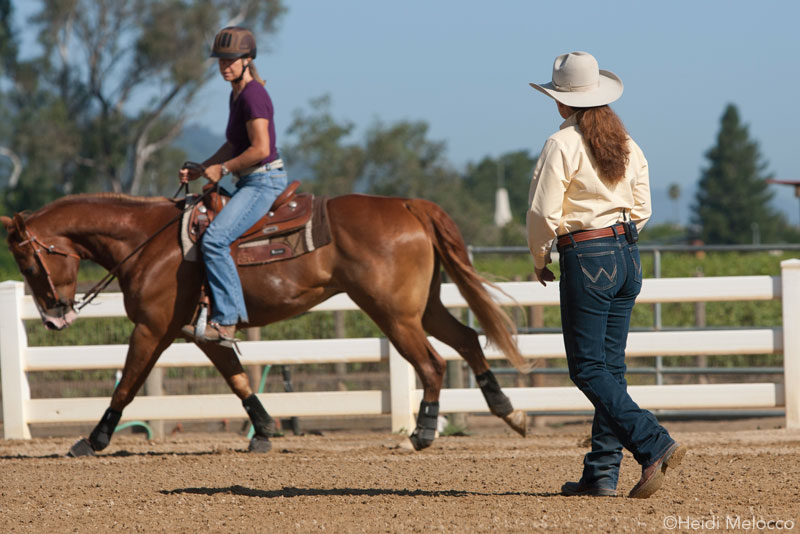Cantering is the topic of choice at many of my clinics. Riders want to know what they can do to canter more easily and how to ride this complex gait with confidence. I often hear, “My horse will never pick up the right lead,” and “What can I do to stop this horrible fast trot that comes before my horse will canter,” as well as, “My horse won’t keep cantering once we get the gait.” These are three of the top cantering complaints. Fortunately, they are easy to fix with a little awareness and effort on your part.

Cue the horse for the canter just before you turn to help him place his hips in the right position to pick up the correct lead.
Cue the Correct Lead
Because you have to cue for both the gait and the lead, there are lots of variations in canter cues, and also lots of confusion. The horse pushes off into the canter with his outside hind leg. If you’re asking for the right lead, the horse first pushes off with the left hind, and vice versa.
Before thinking about the canter, practice this move at the walk in a relaxed and easy frame without thinking about adding speed. You need to be able to reach back and get the horse to yield his haunches (called a haunches-in). Reach back a few inches with your outside leg and apply pulsating pressure there with your Achilles tendon. To prep for a right lead, move your left leg back. A well-trained horse will step his hips to the right.
I like to walk straight down the long side of the arena, reach my leg back, and if the horse yields his hip, I release him and pat him. Eventually, the horse knows that’s the cue to move his hip. The horse is now set up for the correct lead, and you can proceed with the canter cue.
The canter cue sequence I use is outside leg to move the haunches in, then lift up and inward with the inside rein to keep the horse from diving in, and finally, the actual cue to canter comes when I curl my hips in the canter motion (which is a move like pushing a swing). I also like to use a kissing sound. It’s all about the sequence—outside leg, inside rein, push with the seat and kiss. Many people who think their horse has a lead problem find that the problem goes away once they clarify their cueing sequence.
If your horse is still having trouble with leads after working on haunches-in, try cueing your horse right before the turn to the short side of the arena. Make sure to cue before the turn, and not during the turn. If your horse enters the turn, he may take the wrong lead as his hips pop out. This is why circling isn’t a great way to teach a horse to pick up a lead. As you pull your horse into the circle, the horse pulls his hip to the outside, and he can’t pick up the correct lead. If you’re going straight and then just start to turn, he’s still moving correctly at that moment to get the lead.
If the horse will only take one lead, there’s a chance that there’s a physical issue. This is especially true if a horse that usually takes the correct lead suddenly isn’t willing. If that’s the case, have the horse evaluated by a veterinarian or veterinarian who’s also an equine chiropractor. If it’s an old injury, especially on a hind leg, the horse may have learned to compensate and just isn’t as strong when traveling in one direction.
Why Are Canter Leads Important?
It’s difficult for a horse to balance himself if you ride around a corner. If your horse is following your exact cue, he should take the lead you ask for—not just start cantering and choose a lead himself. Plus, for competition, there’s often a required lead depending on the direction you’re tracking or according to the pattern. All that said, if you’re riding straight down the trail or the middle of the arena, there is no correct lead to take. But to be a better horseman, it’s best to know what you’re asking your horse to do.
When riders come to clinics and they want to work on leads, I first ask if the horse takes the wrong lead when traveling both directions. If the horse misses his leads in both directions, there’s most likely a cueing problem. The horse isn’t clear about what lead you want him to take and he isn’t set up to take the correct lead.
Trotting into the Canter
If you think you’re cueing for the horse to canter and instead he just trots faster and faster and faster, you’re probably releasing the cue at the wrong time. Compliant and trained horses can inadvertently learn to take the cue to canter as a cue to trot faster. If the horse mistakes the cue and you continue riding a fast trot, you are accepting that response and telling the horse that he’s doing the right thing. If you stop the horse because he trotted instead of cantering, you are also reinforcing an incorrect response. Once the horse gets a break, he thinks he’s been rewarded and he did the right thing.
Make sure that you have a clear cue. If you’re confident of your cue sequence and your horse still trots faster, let him know that isn’t what you’re asking for. Stop him abruptly and immediately re-cue the canter. If he does it again, abruptly use a stop cue with your seat then reins, but immediately ask for the canter again. Don’t give him a break—the stop is to correct him and then move him immediately forward again. Keep applying the pressure of the whole cueing process until he gives you the right answer and starts to canter.
Avoiding the Canter
The horse’s nose dives down with every stride of the canter as he’s lifting his back and hindquarters and stretching his nose down. This happens especially on the first stride when he moves from no impulsion to full impulsion. If you don’t actively give a release with your reins, the horse hits the bit. If you’re tense and don’t relax your hands, you can be adding to the problem. If your horse has a lazy demeanor and hits the bit, he takes that as full permission to stop cantering. If your horse is sensitive and nervous, he may hit that bit and get scared and therefore lose trust in you as a rider. The solution is the same: As soon as you step into the canter and with every stride, you need to reach forward and down (not up, as that can still hit the horse in the mouth as his head goes down).
Some horses actually become afraid to canter and throw their heads in the air and run in a panic. When I’m attempting to break that habit, I exaggerate and reach farther forward than necessary to show the horse that he can trust me. A nervous rider often pulls back on the reins at the moment of cueing. Even if the rider is just reluctant in their mind, the horse may pick up on that.
If you don’t think you can make an exaggerated change to break this habit with your horse, consider asking a more experienced rider work with him and show you how the canter can look, and to remind the horse that stepping into the canter doesn’t have to mean getting hit in the mouth. You’ll still have to focus on fixing yourself, but you’ll get a boost of confidence seeing someone else riding your horse and knowing what your horse can do.

Make sure to keep your hands in front of the saddle’s pommel. Some horses will take any backward pressure on the reins as a signal to stop. A horse should stay at the gait and speed you dictate until you ask for another move.
Breaking Gait or Falling out of the Canter
I call it “pedaling” when you have to kick with every stride—it’s a workout! Correcting your horse with the amount of pressure that is needed to motivate change will keep you from pedaling. Instead of pushing with every stride, let your horse know that he’s expected to keep moving forward on his own. Once you’re cantering, it’s the horse’s job to keep doing what you asked until you tell him to do something different. However, horses don’t necessarily want to canter around and carry a rider—it’s hard work! Some horses will look for any excuse to stop.
Pulling back on the reins or riding with tension in your arms can be an invitation to break gait. If your horse feels any pressure on the bit, he may take that as a cue to stop.
If you’re riding a turn, you may be pulling back on the reins and giving your horse a cue to stop when you don’t intend to. Use a leading rein—lifting and moving your rein hand forward instead of back toward your pockets. That forward motion with your hands will help the horse know he should keep moving forward. You may not think you’re pulling back on the rein—you just think you’re turning. But if you ride with a direct rein, angled back toward your pockets, that’s pulling back enough to allow a lazy horse to think you want him to stop.
Riders can also accidentally train their horses to break gait by not issuing a reprimand and allowing too much time after the horse breaks gait and before asking the horse to canter again. If the horse got to trot or walk for a few strides before being asked to canter again, he thinks that he got a break and didn’t see a reprimand. He’ll break gait again and again to get that mini-break.
Breaking gait is a serious sign of disobedience, and the horse needs some way to know you’re not happy. You may use your leg aids, tap the ends of your reins on his neck or behind, or verbally hiss at him. You have to find the amount of pressure that motivates change. It is part of a horse’s nature to seek out your acceptance if he sees you as the leader. Part of seeking approval means wanting to please you—and it makes it ultimately important that you do praise your horse when he deserves it.
I would rather teach a horse with one strong correction instead of nagging or kicking with every stride. We aren’t talking about hurting a horse or digging in with spurs—just hissing and giving a spank with the reins one time is much more humane than kicking with every stride.
When you change your body position, change your cues to make them crystal clear, and change your attitude so that you know what to expect of your horse, a well-trained horse will fall in line and be willing to do what you ask. It’s all about clear and consistent cueing and making sure to sequence every cue so that the horse knows what’s coming next and can learn to respond to the lightest pressure.
HEIDI MELOCCO is a journalist, photographer and therapeutic riding instructor—and she loves her Paint Horse, Q. She’s based in Mead, Colo.
This article originally appeared in the February 2015 issue of Horse Illustrated magazine. Click here to subscribe!






Thank You for another great article. I always have a hard time figuring out which lead I am on. I have other problems too, and some of these are addressed in this article. I will have to reread it again.